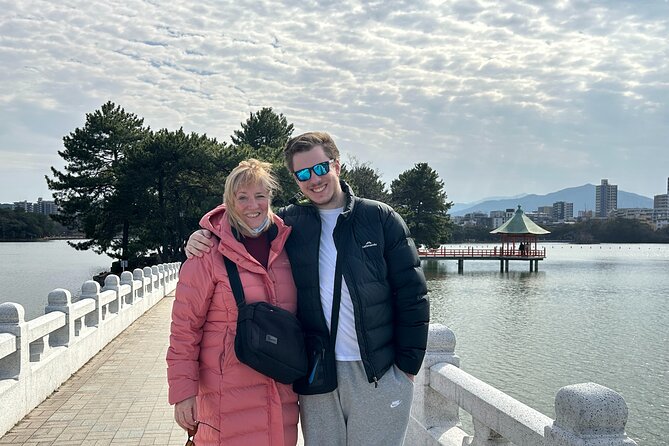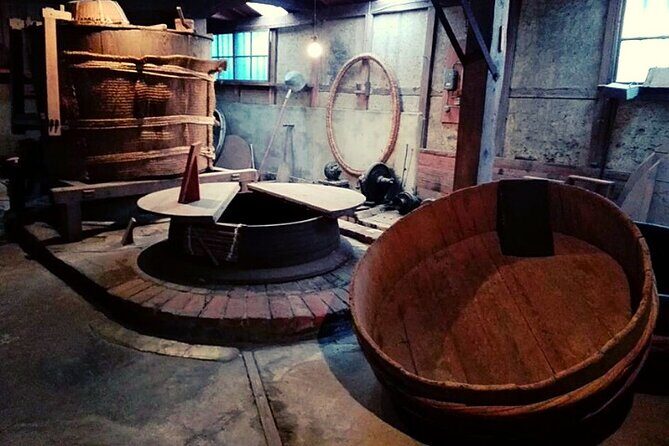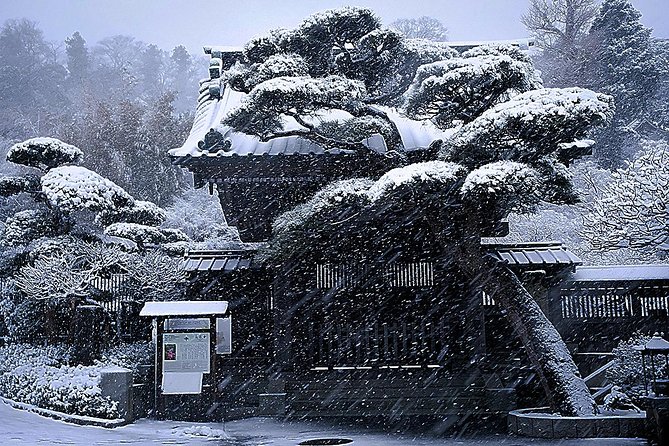The Kyoto Afternoon Tour offers travelers the chance to explore Kyoto’s stunning temples and gardens, seeing the rich traditions of ancient Japan. With knowledgeable guides leading the way, you will visit the vibrant Fushimiinari Taisha Shrine and the awe-inspiring Sanjusangendo Temple, home to 1,001 statues of Kannon. Transportation is provided, and ample photo opportunities are available.
While previous travelers have praised the tour’s guides, some have noted time constraints at each location. With a maximum capacity of 40 participants, this 4-hour tour promises an unforgettable experience in Kyoto.
Key Points

- Fushimiinari Taisha Shrine is one of the most significant Shinto shrines in Japan dedicated to Inari, the god of rice and prosperity, known for its thousands of torii gates.
- Kiyomizu Temple is a symbol of Buddhist influence on Japanese architecture, showcasing skill and craftsmanship, and offering breathtaking panoramic views of Kyoto.
- Sanjusangendo Temple is a must-visit attraction with its 1,001 statues of Kannon, providing an awe-inspiring experience and showcasing ancient artifacts.
- The Kyoto Afternoon Tour offers the opportunity to immerse in Kyoto’s history and culture, explore the city’s unique cultural heritage, engage with local artisans, and participate in traditional Japanese rituals.
Exploring Fushimiinari Taisha Shrine
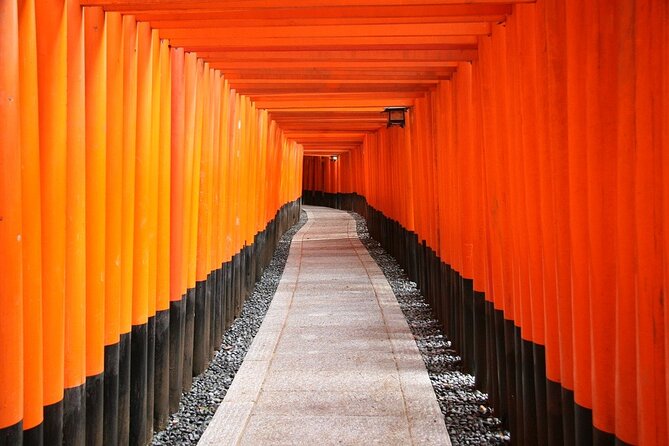
During the Kyoto afternoon tour, travelers have the opportunity to explore Fushimiinari Taisha Shrine with its colorful architecture and gardens.
Fushimiinari Taisha is one of the most significant Shinto shrines in Japan, dedicated to Inari, the god of rice and prosperity. The shrine is famous for its thousands of torii gates, forming vibrant pathways that lead visitors through the sacred grounds.
These gates, donated by individuals and businesses, are seen as a symbol of gratitude and wishes for good fortune. As visitors make their way through the shrine, they can witness various rituals performed by worshippers, such as purification ceremonies and prayers for success in business.
The serene atmosphere, coupled with the mesmerizing sight of the torii gates, makes Fushimiinari Taisha an enchanting and spiritually uplifting experience.
Here's some other great tours and experiences that we think you'll like.
Discovering the Colorful Architecture and Gardens
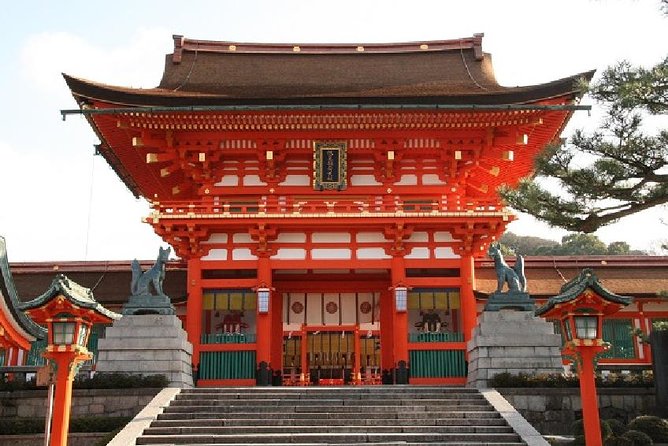
Visitors on the tour can explore the colorful architecture and gardens at Fushimiinari Taisha Shrine. The shrine is renowned for its symbolic structures and tranquil gardens, offering a captivating experience that embodies the essence of Japanese culture. Here are three reasons why the architecture and gardens are a must-see:
- Symbolism in Japanese architecture: The vibrant colors and intricate designs of the shrine’s buildings hold deep symbolic meanings. From the vermillion torii gates that mark the entrance to the ornate main hall, every element represents a spiritual connection and reflects the unique cultural heritage of Japan.
- The significance of gardens in Japanese culture: The meticulously manicured gardens surrounding the shrine provide a serene atmosphere for contemplation and reflection. These gardens are meticulously designed to harmonize with nature, showcasing the Japanese belief in the importance of finding balance and tranquility in one’s surroundings.
- A feast for the senses: The architecture and gardens at Fushimiinari Taisha Shrine offer a visual feast, with vibrant colors, intricate details, and serene landscapes. Visitors can enjoy the beauty and serenity of the surroundings, allowing them to feel a sense of freedom and escape from the outside world.
Uncovering the History of Kiyomizu Temple

Travelers can uncover the fascinating history of the renowned Kiyomizu Temple, known for its historical significance and stunning views of Kyoto. This iconic temple has been a symbol of Buddhist influence on Japanese architecture for centuries. The temple’s unique design, built without the use of any nails, showcases the skill and craftsmanship of the time. The main hall, perched on a steep hillside, offers breathtaking panoramic views of the city. Kiyomizu Temple has played a crucial role in preserving Kyoto’s cultural heritage. It has survived multiple fires and wars, standing as a testament to the resilience and determination of the people. Today, visitors can explore the temple grounds, admire its intricate details, and experience a sense of freedom and peace in this sacred place.
| Influence of Buddhism on Kiyomizu Temple architecture | Role of Kiyomizu Temple in preserving Kyoto’s cultural heritage | Emotional Response |
| The temple’s design showcases the influence of Buddhism, with its traditional wooden architecture and intricate carvings. | Kiyomizu Temple has stood the test of time, preserving Kyoto’s cultural heritage for generations to come. | Visitors can feel a sense of awe and reverence as they explore the temple and learn about its history. |
| The use of natural materials, such as wood and stone, creates a harmonious connection with the surrounding nature. | The temple serves as a reminder of the rich cultural legacy of Kyoto, inspiring a sense of pride and appreciation. | The stunning views from the temple’s main hall evoke a sense of tranquility and wonder. |
| The temple’s architecture reflects the Buddhist principles of simplicity, balance, and mindfulness. | Kiyomizu Temple is a living testament to the traditions and customs that have shaped Kyoto’s identity. | The serene atmosphere of the temple grounds invites introspection and contemplation. |
| The temple’s structural integrity, despite its challenging hillside location, showcases the ingenuity and skill of the craftsmen. | Kiyomizu Temple stands as a symbol of resilience and perseverance, inspiring visitors to overcome obstacles in their own lives. | The historical significance of the temple elicits a sense of reverence and appreciation for the past. |
| The temple’s design incorporates elements of nature, such as cherry blossoms and maple trees, enhancing its beauty and connection to the environment. | Kiyomizu Temple is a cultural treasure that helps to keep Kyoto’s traditions alive and vibrant. | The spiritual energy of the temple resonates with visitors, leaving a lasting impression and a sense of renewal. |
Taking in Ancient Traditions at Sanjusangendo Temple
Immersing themselves in ancient traditions, participants of the guided tour have the opportunity to explore Sanjusangendo Temple and marvel at its 1,001 statues of Kannon. This magnificent temple, located in Kyoto, Japan, is a testament to the unique cultural heritage of the country.
As visitors enter the temple, they are immediately captivated by the sheer number of statues lining the hall. Each intricately carved figure represents the deity of mercy, Kannon. The experience is truly awe-inspiring, evoking a sense of reverence and wonder.
Beyond the statues, the temple also houses a collection of ancient artifacts, showcasing the craftsmanship and artistry of the past. Traditional Japanese rituals are still practiced within the temple, adding an element of authenticity to the visit. It is a unique opportunity to witness and participate in these sacred rituals, connecting with Japan’s spiritual heritage.
Captivating Photo Opportunities at the Temples and Shrines
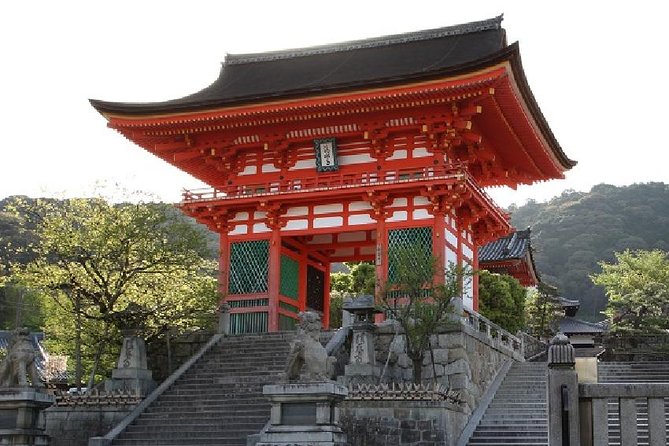
Participants on the guided tour have the opportunity to capture captivating photos at the picturesque temples and beautiful gardens in Kyoto. With its fascinating history and stunning architecture, Kyoto offers a wealth of photo-worthy locations. Here are some photography tips for capturing the beauty of Kyoto’s temples:
First, pay attention to composition. Look for interesting angles and perspectives that highlight the intricate details of the temples. Experiment with different framing techniques to create visually pleasing shots.
Second, make use of natural light. Kyoto’s temples often have open courtyards and large windows that allow for beautiful natural light to filter in. Take advantage of this soft, diffused light for more flattering and atmospheric photos.
Lastly, don’t forget to capture the significance of religious monuments in Japanese culture. Many of Kyoto’s temples have deep spiritual and cultural significance. Take the time to learn about the history and traditions associated with each temple, and try to convey that in your photographs.
The Perfect Afternoon Tour in Kyoto
The captivating photo opportunities at the temples and shrines in Kyoto have surely left visitors in awe. Now, let’s delve into the perfect afternoon tour in Kyoto.
This tour takes you to the iconic Fushimiinari Shrine and Kiyomizu Temple, providing a glimpse into the rich traditions of ancient Japan.
- Best time to visit: The afternoon tour offers a unique experience, as you can witness the stunning sunset at Kiyomizu Temple and see the illuminated torii gates at Fushimiinari Shrine in the evening.
- Local food recommendations: After exploring these cultural gems, indulge in some local delicacies. Try the mouthwatering kaiseki (traditional multi-course meal) or savor the flavors of Kyoto-style sushi and matcha desserts.
- Enjoy the beauty of Kyoto’s history and culture while indulging in the city’s delectable cuisine. This afternoon tour promises an unforgettable experience for those seeking freedom and a deeper understanding of Japan’s ancient traditions.
Here's some more great Japan experiences nearby that we think you'll like.
Frequently Asked Questions
What Is the Best Way to Get to the Meeting Point at Avanti Tour Desk Near Kyoto Station?
The best way to get to the meeting point at Avanti Tour Desk near Kyoto Station is to use public transportation, such as buses or trains. Alternatively, taxis or rideshare services are also convenient options.
Can I Join the Tour if I Am Traveling Alone?
Solo travelers are welcome to join the tour. While there may not be specific group discounts, the experience offers an opportunity to explore Kyoto’s temples and shrines, gaining insight into ancient traditions.
Are There Any Age Restrictions for Participating in the Tour?
There are no age restrictions for participating in the tour, and you can join even if they are traveling alone. It offers an opportunity to explore picturesque temples and gain insight into ancient Japanese traditions.
Is There Any Free Time to Explore the Temples and Gardens on Our Own During the Tour?
Yes, there is time to wander and explore the temples and gardens at your own pace during the tour. You can take in the beauty and tranquility of these sites at your leisure.
Is Food or Drinks Included in the Tour Package?
Food and drinks are not included in the tour package. However, participants have the freedom to explore the local cuisine during the tour. There may be opportunities to purchase snacks or beverages at certain locations.
The Sum Up
To sum it up, the Kyoto Afternoon Tour offers an engaging and informative experience for travelers seeking to explore the rich traditions of ancient Japan.
With visits to the stunning Fushimiinari Taisha Shrine, the colorful Kiyomizu Temple, and the historic Sanjusangendo Temple, you will be immersed in the beauty and history of Kyoto.
The knowledgeable guides provide insightful commentary, while the tour’s transportation ensures a hassle-free experience.
Although some travelers have mentioned feeling rushed at times, the tour’s positive reviews and captivating photo opportunities make it a perfect choice for an unforgettable afternoon in Kyoto.
Where To Stay In Tokyo
Tokyo visitor levels are currently at an all-time high so make sure to book your hotels early. Tip most hotels booked with booking.com have free cancelation so book as soon as you know your date and you can always cancel if you change your mind.

